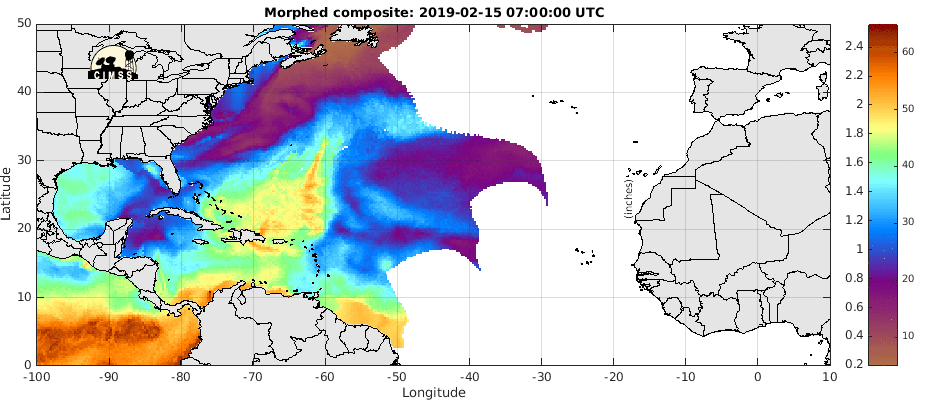National Weather Service Houston/Galveston TX
637 PM CDT Tue Aug 1 2017
.AVIATION...
First portion of the forecast looks generally on track, with VFR
conditions across the area and winds slowly coming down through
the evening. Big picture for the back half also appears good, but
uncertainty about the details - including the potential for
heavier rain - remains at this time.
As an upper disturbance swings into Southeast Texas, feel there`s
enough confidence to start bringing in TEMPOs for rain/storms at
the northern sites. The question comes closer to the coast, as
convergence in winds seen today over Colorado/Austin/Wharton
counties will set up and become the dominant feature for our
Houston and coastal TAF sites. While the blanket VCs seem
reasonable, whether the northern feature or the coastal feature
become dominant may impact the timing of when the best coverage of
storms is possible farther south by several hours. For now, both
scenarios seem plausible, so will punt on probs/tempos for this
cycle, and look for more clarity with the evening model runs.
It does seem likely that around 00Z, most of the rain will be
ending or at least moving east of the TAF sites. For most, this is
the end of period so I don`t explicitly forecast this at this time,
but does show up in the extended portion of the IAH TAF.
Luchs
&&
.PREV DISCUSSION... /ISSUED 358 PM CDT Tue Aug 1 2017/
DISCUSSION...
Gulf moisture nosing back into the region this afternoon had
allowed for a few showers to develop along and south/east of the
Highway 59 corridor, but most of the region has remained dry
today. However, recent dryness will quickly change to a relatively
wet pattern for Southeast Texas for early August as an
approaching disturbance from the Southern Plains reaches the
region later tonight into Wednesday.
Most shower activity is expected to dissipate with loss of
daytime heating this evening, but another round of rain will
approach the region from the north and northwest tonight into
early Wednesday morning as the upper level disturbance arrives.
Additionally, afternoon surface analysis shows several distinctive
surface convergence zones or boundaries located across the
northwest Gulf. Height falls on the order of 2-4 decameters
tonight may result in enough of a surface reflection/trough to
draw one or both of these boundaries inland... but several
questions still exist on when, which one(s), or how far inland
they will travel but will need to monitor areas along and
south/east of Highway 59 based on consensus from 12Z guidance.
Convergence along these features should result in continued
shower development across the waters overnight with coverage
gradually spreading into the coastal counties along any one of
these boundaries. As the upper disturbance passes across the
region on Wednesday, additional showers and thunderstorms may
focus along whatever boundaries move inland. With forecast
soundings showing precipitable water values rising into the
2.2-2.4 inch range (near the 99th percentile for August), locally
heavy rain will be possible with any shower or thunderstorm that
develops tomorrow. Luckily, recent July rainfall deficits of
anywhere from 1-3 inches below normal should help mitigate against
any widespread threat... but a splitting (albeit weak) 250-300 MB
jet over the region during the day should be enough to support
high rain rates and this may result in minor flooding issues in
urbanized areas.
The main energy from the upper disturbance looks to clear the
region Wednesday night into Thursday morning with subsidence
behind this feature expected to result in a temporary decrease in
rain chances during the overnight hours. However, a secondary
shot of energy moving across the region during the day Thursday
should result in the development of another round of scattered
showers and thunderstorms into Thursday night before this energy
clears the region.
Northwest flow aloft will persist across the region through the
end of the work week and into the weekend, with rain chances
highest over the coastal waters at night and inland during the
day. Any smaller disturbance translating across the region during
this time in the flow aloft would certainly result in an
enhancement to coverage, but pinpointing any of those features (or
timing) at this point out is incredibly difficult. One such
disturbance may send a cold front into Texas by Friday, but with
the disturbance quickly pulling east across the Great Lakes the
front appears to lose too much of its upper level support to make
it into the region.
Temperatures over the next few days should remain near to below
seasonal normals due to rain and cloud cover, with highs in the
upper 80s to mid 90s and lows in the 70s to low 80s.
Huffman






